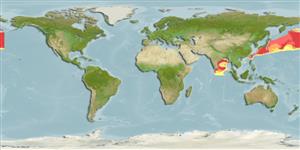Elasmobranchii (Haie und Rochen) (sharks and rays) >
Squaliformes (Sleeper and dogfish sharks) >
Somniosidae (Sleeper sharks)
Etymology: Scymnodon: scymnus, an ancient name for some kind of shark, derived from a Greek word meaning young animal, cub or whelp; odon (Gr.), tooth, referring to large, triangular cutting teeth on lower jaw of S. ringens. (See ETYFish); ichiharai: In honor of marine biologist (specializing in whales) Tadayoshi Ichihara (d. 1981), Tokai University (Tokyo, Japan), who suggested that the authors study this shark. (See ETYFish).
More on authors: Yano & Tanaka.
Environment: milieu / climate zone / depth range / distribution range
Ökologie
seewasser bathypelagisch; tiefenbereich 500 - 800 m (Ref. 31249). Deep-water
Indo-West Pacific: Japan (Ref. 31249) and India (Ref. 118627).
Size / Gewicht / Alter
Maturity: Lm ? range ? - ? cm
Ovoviviparous (Ref. 205).
Life cycle and mating behavior
Maturities | Fortpflanzung | Spawnings | Egg(s) | Fecundities | Larven
Distinct pairing with embrace (Ref. 205).
Yano, K and S. Tanaka, 1984. Review of the deep sea squaloid shark genus Scymnodon of Japan, with a description of a new species. Jap. J. Ichthyol. 30(4):341-360. (Ref. 31249)
IUCN Rote Liste Status (Ref. 130435)
Bedrohung für Menschen
Harmless
Nutzung durch Menschen
Tools
Zusatzinformationen
Download XML
Internet Quellen
Estimates based on models
Phylogenetic diversity index (Ref.
82804): PD
50 = 0.7500 [Uniqueness, from 0.5 = low to 2.0 = high].
Bayesian length-weight: a=0.00389 (0.00168 - 0.00901), b=3.13 (2.94 - 3.32), in cm total length, based on LWR estimates for this (Sub)family-body shape (Ref.
93245).
Trophic level (Ref.
69278): 4.2 ±0.7 se; based on size and trophs of closest relatives
Widerstandsfähigkeit (Ref.
120179): niedrig, Verdopplung der Population dauert 4,5 - 14 Jahre. (Fec assumed to be <100).
Fishing Vulnerability (Ref.
59153): Very high vulnerability (84 of 100).
